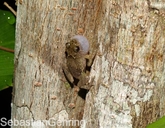|
Description
M 17-22 mm, F 18-21 mm. Tympanum distinct, 1/2 of eye diameter. Tibiotarsal articulation reaches the tympanum. Toe 3 longer than toe 5. Skin smooth or slightly granular. Colour extremely variable, usually without green. Dorsally brownish, uniform or with symmetrical light and dark markings. Ventrally greyish to brown (Glaw and Vences 2007).
Similar species: Especially A. moramora and A. nigrigularis (Glaw and Vences 2007).
Variation: This species occurs over a large area of Madagascar�s east coast and may consist of several species. Populations from Masoala are genetically differentiated and are currently being described as a distinct species (Glaw and Vences 2007). Distribution and Habitat
Country distribution from AmphibiaWeb's database: Madagascar
Species is located in Ambohimanga Atsimo, Andasibe, Ankeniheny, Fenoarivo, Italaviana, Ivoloina, Mahavelona, Manombo, Maroantsetra, Nosy Boraha, Ranomafana, Tampolo (Fenoarivo). Specimens from Masoala and Nosy Mangabe probably belong to a different species (Glaw and Vences 2007). It has been recorded from sea level up to 1300m asl (Vences and Glaw 2008).Life History, Abundance, Activity, and Special Behaviors
Habits: Males call at night from tree trunks at 1-2 m perch height. Eggs in water-filled tree holes or Ravenala leaf axils, guarded by the male. Common in low-altitude rainforest as well as in secondary or degraded vegetation (Glaw and Vences 2007).
Calls: A single short melodious note that is repeated after regular intervals. Note repetition rate 140-175/min (Glaw and Vences 2007).
Trends and Threats
Species is listed as least concern because of its wide distribution, tolerance of a degree of habitat modification, presumed large population, and because it is unlikely to be declining fast enough to qualify for listing in a more threatened category (Vences and Glaw 2008). Though it occurs in many protected areas, its forest habitat is receding due to subsistence agriculture, timber extraction, charcoal manufacture, and invasive spread of eucalyptus, livestock grazing and expanding human settlements (Vences and Glaw (2008). Possible reasons for amphibian decline General habitat alteration and loss
Habitat modification from deforestation, or logging related activities
Intensified agriculture or grazing
Urbanization
Comments
Taken with permission from Glaw and Vences (2007) and Vences and Glaw (2008).
References
Glaw, F., and Vences, M. (2007). Field Guide to the Amphibians and Reptiles of Madagascar. Third Edition. Vences and Glaw Verlag, Köln.
Vences, M. and Glaw, F. (2008). Anodonthyla boulengerii. In: IUCN 2008. 2008 IUCN Red List of Threatened Species. www.iucnredlist.org. Downloaded on 06 May 2009.
Originally submitted by: Miguel Vences and Frank Glaw (first posted 2002-01-25)
Edited by: Catherine Aguilar (2010-07-18)Species Account Citation: AmphibiaWeb 2010 Anodonthyla boulengerii <https://amphibiaweb.org/species/2326> University of California, Berkeley, CA, USA. Accessed Jun 10, 2025.
Feedback or comments about this page.
Citation: AmphibiaWeb. 2025. <https://amphibiaweb.org> University of California, Berkeley, CA, USA. Accessed 10 Jun 2025.
AmphibiaWeb's policy on data use.
|
